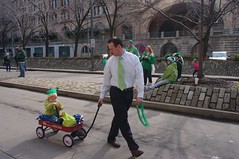 What to Expect the First Year by Heidi Murkoff
What to Expect the First Year by Heidi MurkoffMy rating: 2 of 5 stars
A book on baby parenting is trying to supplement two other sources. For your average baby, it supplements the advice that one used to get from a myriad of aunties and grandmas who were close at hand to benefit from the experience of raising children. For the not-so average event, it supplements the pediatrician, who benefits from the experience of working with hundreds or thousands of children. And so the 'What to Expect' book provides exactly what the title says. 'What to Expect'. But the moment that an individual infant deviates from the average, it begins to fail.
What to expect is organized strictly on a month by month basis. Within each month there is a discussion of standard developmental milestones, and discussion of issues that are expected to arise in each month. The problem is, babies are highly variable. Like good baby books, What to expect acknowledges this basic fact. But because of its organization, you can't find information unless you are examining the 'correct' month. And at this point the usefulness of the book quickly drops.
Runner's have a saying, we are experiments of one. While it makes sense to talk of developmental milestones (especially since we can't ask babies about themselves and get useful answers so milestones, and appetite, are all we have to work with), there are a number of ways of deviating from the norm. Substantially. What to Expect explains the norm. Which is useful before the baby arrives. But when you have an actual baby, even by the first month there are ways babies vary from the majority. Basically, any condition that is described as "n% of babies are ____" will represent deviations from the norm. Two very common examples are colicky babies (~20%) and preemies (~12%) (we have a colicky baby). The book quickly has notes that such babies are different, and can even discuss it in a relavent section. The problem is that now everything else is off. But if you are going through the book month by month, this is not obvious. And month by month, every developmental milestone discussed is off when compared to the real, living, eating, crying, squirming example of a baby that is with you.
There are other ways of doing this. Sears' The Baby Book has a section that is month by month milestones, organized in three sections per month based on probability (probably is able, may be able, sometimes can). But other topics are approached separately from the timeline, encouraging readers to think of them outside the timeline. This approach is much better then the What to Expect approach that organizes everything on the timeline.
In summary, 'What to Expect' is useful, if you have the average baby. It can be useful before birth (which is the definition of 'expect'). But if your baby falls into any special category (even mundane specials like colic or premature), regular reading of 'What to Expect' will lead to madness.
View all my reviews





